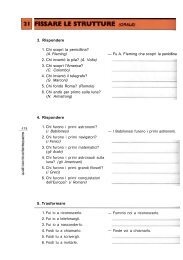III. The Beginnings of Transformation
III. The Beginnings of Transformation
III. The Beginnings of Transformation
Create successful ePaper yourself
Turn your PDF publications into a flip-book with our unique Google optimized e-Paper software.
BEGINNINGS OF TRANSFORMATION<br />
it was one <strong>of</strong> the cities Alexius rebuilt. 62<br />
Because <strong>of</strong>its geographical location<br />
and Turkish pressure from the north, the city was largely isolated in terms<br />
<strong>of</strong> land communication. John Comnenus made two expeditions in the<br />
regions to the north <strong>of</strong> Attaleia in order to settle conditions there, but<br />
evidently he achieved only partial success. 63<br />
By the time <strong>of</strong> the Second<br />
Crusade (1147), Attaleia was so hard pressed by the Turks that the<br />
inhabitants could not cultivate their fields and as has already been<br />
mentioned they had to bring grain by sea. 64<br />
During the revolt <strong>of</strong><br />
Andronicus Comnenus (1182) the sultan <strong>of</strong>Konya subjected the city to a<br />
severe siege. 65<br />
<strong>The</strong> mountainous regions to the east <strong>of</strong>the river valleys, which separate<br />
the Anatolian plateau from the coastal districts, constituted areas <strong>of</strong><br />
almost continuous strife. This geographical district, stretching from<br />
Dorylaeum in the northwest to Iconium in the southeast came to be a<br />
no-man's land which Greeks, Turks, and Crusaders repeatedly devastated.<br />
On the northern edge <strong>of</strong> this region the Bithynian towns and countryside<br />
experienced numerous raids immediately following the battle <strong>of</strong> Manzikert.<br />
Nicomedia, recaptured by the Byzantines in the late eleventh century,<br />
was still a "l<strong>of</strong>ty ruins" set among thorns and bushes in the mid-twelfth<br />
century. 66<br />
Nicaea, while yet in the hands <strong>of</strong> the Turks, was besieged by the<br />
emir Burzuk for three months, 67<br />
and shortly thereafter by Buzan. 68<br />
reconquest <strong>of</strong> the city by the Crusaders entailed some difficulties, for the<br />
unruly troops <strong>of</strong> Peter the Hermit pillaged the houses and churches en<br />
route to Nicomedia. In the north the depredations begun by the Norman<br />
mercenary Roussel terminated in the destruction <strong>of</strong> both towns by the<br />
Turks who left them desolate ruins. 69<br />
<strong>The</strong><br />
<strong>The</strong> Turks once more laid siege to<br />
Nicaea in 1113, when they ravaged Bithynia and the Propontis. 70<br />
In the<br />
latter half <strong>of</strong> the twelfth century the pressure <strong>of</strong> the Turks about the<br />
Bithynian region, as well as an abortive rebellion against Andronicus<br />
Comnenus, brought some hardship to Nicaea. 71<br />
Prusa experienced<br />
practically the same history as Nicaea down to the end <strong>of</strong> the twelfth<br />
century. <strong>The</strong> fate <strong>of</strong> eastern Bithynia, however, is not at all clear, with the<br />
solitary exception <strong>of</strong> Claudiopolis which almost fell to the Turks but was<br />
62<br />
Anna Comnena, <strong>III</strong>, 142. Al-Idrisi, II, 134, refers to it as the "Burnt," and remarks<br />
that it is built away from the old site, but this probably refers to Side. See A. M. Mansel,<br />
Die Ruinen von Side<br />
879-918.<br />
(Berlin, 1963); Mansel, "Side," P.W., Supplementband, X (1965),<br />
6 3<br />
Nicetas Choniates, 17-19, 50. Cinnamus, 7, 22. <strong>The</strong>odore Scutariotes-Sathas,<br />
190-191, 208.<br />
6 4<br />
William <strong>of</strong> Tyre, XVI, xxvi.<br />
65<br />
Nicetas Choniates, 340.<br />
6 6<br />
Odo <strong>of</strong> Deuil, pp. 88-89.<br />
6 7<br />
Anna Comnena, II, 72.<br />
6 8<br />
Ibid., II, 74. Matthew <strong>of</strong> Edessa, p. 203.<br />
6 9<br />
Anna Comnena, II, 210. Attaliates, 267-268. In the days <strong>of</strong>Michael VII this region<br />
had become " . . .<br />
7 0<br />
Anna Comnena, <strong>III</strong>, 164.<br />
7 1<br />
Nicetas Choniates, 363-371, 658.<br />
. . ." Gesta Francorum, pp. 6-9.<br />
152






